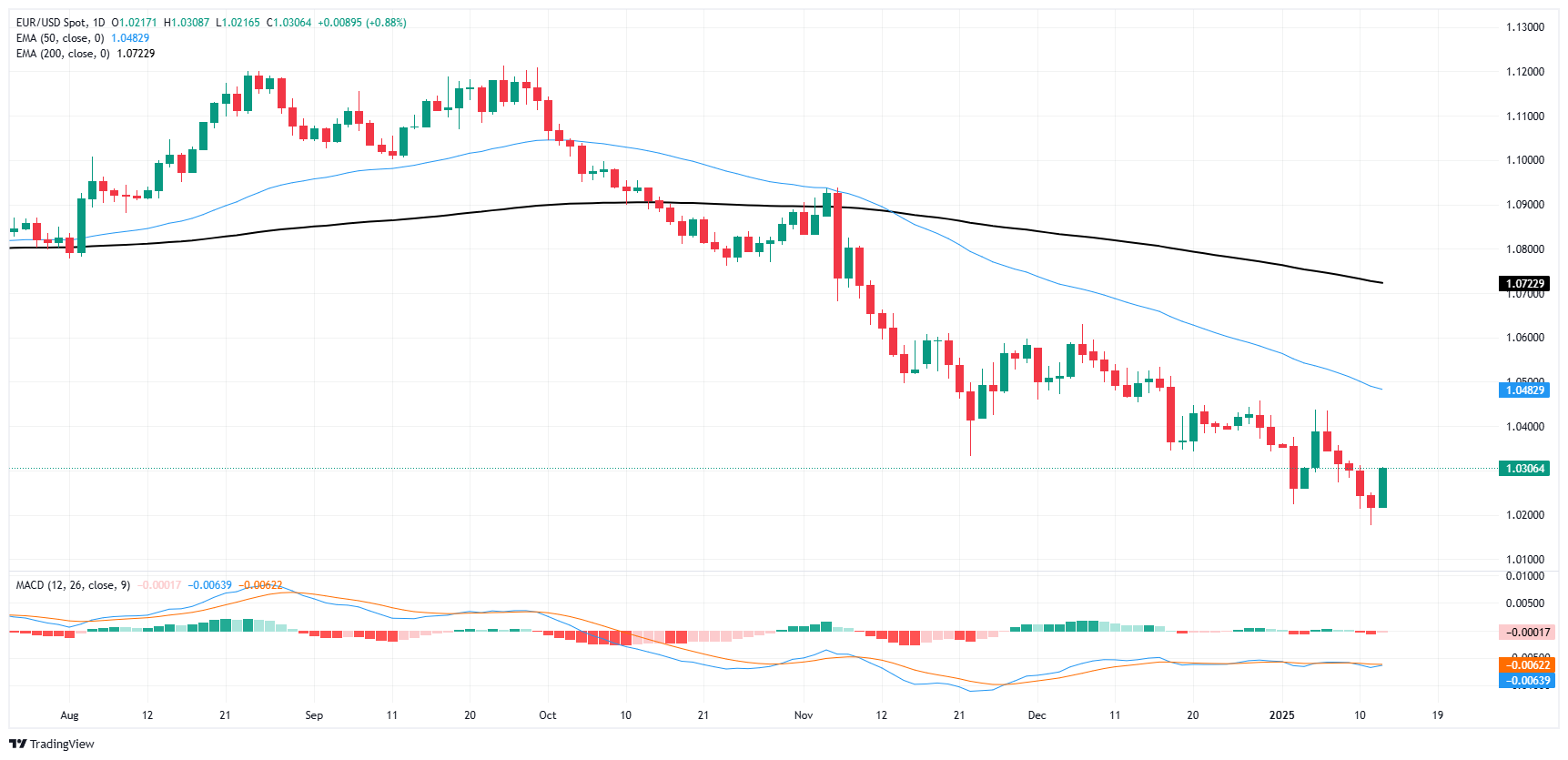EUR/USD looks up from the low end ahead of key CPI print
- EUR/USD rose on Tuesday, reclaiming the 1.0300 handle.
- Euro traders are holding out hopes that a French accord will avoid government collapse.
- Key US CPI inflation figures are due on Wednesday.
EUR/USD found enough gas in the tank for an intraday rally on Tuesday, rising over eight-tenths of one percent on the day as Euro bidders hope that a potential accord in France could stave off a total collapse of the European country’s government. Market sentiment improved on Tuesday, further bolstering Fiber bidding after US Producer Price Index (PPI) inflation rose at a slower pace than expected. Economic data remains limited on the European side of the market space, leaving Fiber traders to grapple with overall Greenback flows.
Headline PPI inflation increased to 3.3% YoY, up from 3.0% previously, while core PPI rose to 3.5% YoY, compared to the earlier rate of 3.4%. Although both sides of the print came in below expectations, inflationary pressures persist in the background, albeit at a slightly reduced intensity than many economists had predicted. With inflation indicators continuing to exceed the Federal Reserve's (Fed) annual targets, PPI results coming in below forecasts provide little distinction concerning the outlook for interest rate cuts.
Regarding the US data for Wednesday, CPI is anticipated to rise to 2.9% YoY from the previous 2.7%, remaining well above the Fed’s 2.0% annual inflation target.
EUR/USD price forecast
EUR/USD rallied back into the 1.0300 handle on Tuesday, heading into Wednesday on a notable upswing, however the pair remains buried deep into the bearish side of the charts. The pair briefly slumped below 1.0200 earlier this week, chalking in a fresh 265-month low.
Fiber is trading well below it’s 200-day Exponential Moving Average (EMA) after facing a technical rejection to the downside from the key moving average in November. While 1.0200 could prove to be a convenient near-term technical floor for bulls to stage a recovery, cool-headed traders will wait and look for signs of a higher low as EUR/USD breathes its way through the first quarter.
EUR/USD daily chart
Euro FAQs
The Euro is the currency for the 19 European Union countries that belong to the Eurozone. It is the second most heavily traded currency in the world behind the US Dollar. In 2022, it accounted for 31% of all foreign exchange transactions, with an average daily turnover of over $2.2 trillion a day. EUR/USD is the most heavily traded currency pair in the world, accounting for an estimated 30% off all transactions, followed by EUR/JPY (4%), EUR/GBP (3%) and EUR/AUD (2%).
The European Central Bank (ECB) in Frankfurt, Germany, is the reserve bank for the Eurozone. The ECB sets interest rates and manages monetary policy. The ECB’s primary mandate is to maintain price stability, which means either controlling inflation or stimulating growth. Its primary tool is the raising or lowering of interest rates. Relatively high interest rates – or the expectation of higher rates – will usually benefit the Euro and vice versa. The ECB Governing Council makes monetary policy decisions at meetings held eight times a year. Decisions are made by heads of the Eurozone national banks and six permanent members, including the President of the ECB, Christine Lagarde.
Eurozone inflation data, measured by the Harmonized Index of Consumer Prices (HICP), is an important econometric for the Euro. If inflation rises more than expected, especially if above the ECB’s 2% target, it obliges the ECB to raise interest rates to bring it back under control. Relatively high interest rates compared to its counterparts will usually benefit the Euro, as it makes the region more attractive as a place for global investors to park their money.
Data releases gauge the health of the economy and can impact on the Euro. Indicators such as GDP, Manufacturing and Services PMIs, employment, and consumer sentiment surveys can all influence the direction of the single currency. A strong economy is good for the Euro. Not only does it attract more foreign investment but it may encourage the ECB to put up interest rates, which will directly strengthen the Euro. Otherwise, if economic data is weak, the Euro is likely to fall. Economic data for the four largest economies in the euro area (Germany, France, Italy and Spain) are especially significant, as they account for 75% of the Eurozone’s economy.
Another significant data release for the Euro is the Trade Balance. This indicator measures the difference between what a country earns from its exports and what it spends on imports over a given period. If a country produces highly sought after exports then its currency will gain in value purely from the extra demand created from foreign buyers seeking to purchase these goods. Therefore, a positive net Trade Balance strengthens a currency and vice versa for a negative balance.


